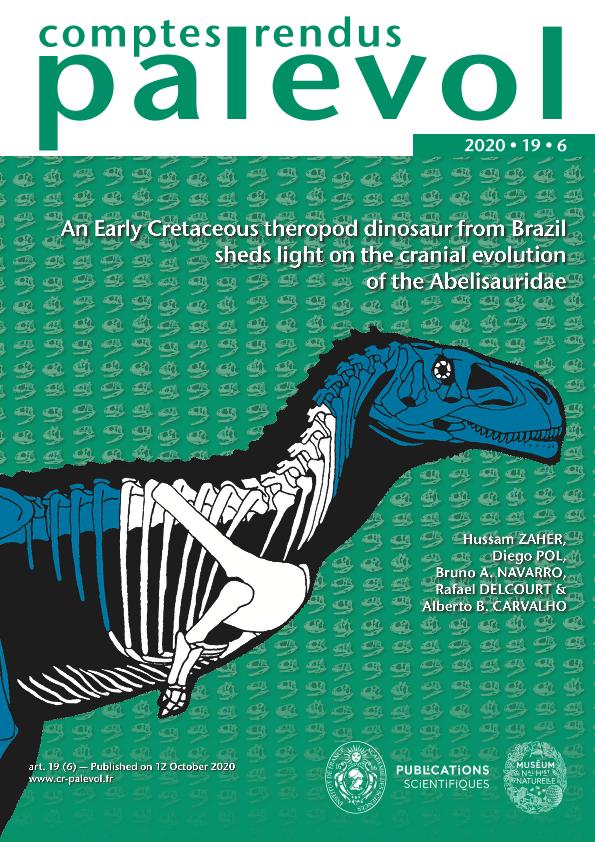Mostrar el registro sencillo del ítem
dc.contributor.author
Zaher, Hussam

dc.contributor.author
Pol, Diego

dc.contributor.author
Navarro, Bruno A.
dc.contributor.author
Delcourt, Rafael
dc.contributor.author
Carvalho, Alberto B.
dc.date.available
2022-03-22T03:10:10Z
dc.date.issued
2020-10-12
dc.identifier.citation
Zaher, Hussam; Pol, Diego; Navarro, Bruno A.; Delcourt, Rafael; Carvalho, Alberto B.; An Early Cretaceous theropod dinosaur from Brazil sheds light on the cranial evolution of the Abelisauridae; Elsevier France-Editions Scientifiques Medicales Elsevier; Comptes Rendus Palevol; 19; 12-10-2020; 101-115
dc.identifier.issn
1631-0683
dc.identifier.uri
http://hdl.handle.net/11336/153682
dc.description.abstract
Abelisaurid theropods dominated the predator role across Gondwana during the Late Cretaceous. They are characterized by highly reduced forelimbs and one of the most specialized cranial morphologies among carnivorous dinosaurs, exemplified by a broad skull, short rostrum, high occipital region, and highly kinetic intramandibular joint, suggestive of a specialized feeding strategy. Late Cretaceous abelisaurids are known from some remarkably complete taxa with well-preserved skulls. However, little is known about the pattern of character transformation that led to their highly modified condition because there are no well-preserved abelisaurids before the Late Cretaceous. Here we report a basal abelisaurid from the Early Cretaceous of Brazil that preserves a complete skull and reveals an early stage in the cranial evolution of the group. It lacks the specialized temporal and mandibular features characteristic of derived abelisaurids, including the kinetic intramandibular joint and knoblike dorsal projection of the parietals.
dc.description.abstract
Les théropodes abélisauridés ont occupé la place de prédateur dans tout le Gondwana au cours du Crétacé supérieur. Ils sont caractérisés par des membres antérieurs très réduits et par l’une des morphologies crâniennes les plus spécialisées parmi les dinosaures carnivores, illustrée par un crâne large, un rostre court, une région occipitale haute et une articulation intramandibulaire très cinétique, ce qui suggère une stratégie d’alimentation spécialisée. Les abélauridés du Crétacé supérieur sont connus grâce à certains taxons remarquablement complets dont le crâne est bien conservé. Cependant, on sait peu de choses sur le schéma de transformation des caractères qui a conduit à leur état très modifié, car il n’existe pas d’abélisauridés bien conservés avant le Crétacé supérieur. Nous présentons ici un abélisauridé basal du Crétacé inférieur du Brésil qui conserve un crâne complet et révèle un stade précoce de l’évolution crânienne du groupe. Il lui manque les caractéristiques temporelles et mandibulaires spécialisées caractéristiques des abélisauridés dérivés, notamment l’articulation cinétique intramandibulaire et la projection dorsale en forme de bouton des pariétaux.
dc.format
application/pdf
dc.language.iso
eng
dc.publisher
Elsevier France-Editions Scientifiques Medicales Elsevier

dc.rights
info:eu-repo/semantics/openAccess
dc.rights.uri
https://creativecommons.org/licenses/by-nc-sa/2.5/ar/
dc.subject
ABELISAURIDAE
dc.subject
APTIAN
dc.subject
CERATOSAURIA
dc.subject
NEW GENUS
dc.subject
NEW SPECIES
dc.subject
QUIRICÓ FORMATION
dc.subject.classification
Paleontología

dc.subject.classification
Ciencias de la Tierra y relacionadas con el Medio Ambiente

dc.subject.classification
CIENCIAS NATURALES Y EXACTAS

dc.title
An Early Cretaceous theropod dinosaur from Brazil sheds light on the cranial evolution of the Abelisauridae
dc.title
Un dinosaure théropode du Crétacé inférieur du Brésil met en lumière l’évolution crânienne des Abelisauridae
dc.type
info:eu-repo/semantics/article
dc.type
info:ar-repo/semantics/artículo
dc.type
info:eu-repo/semantics/publishedVersion
dc.date.updated
2022-03-14T21:09:38Z
dc.identifier.eissn
1777-571X
dc.journal.volume
19
dc.journal.pagination
101-115
dc.journal.pais
Francia

dc.description.fil
Fil: Zaher, Hussam. Universidade de Sao Paulo; Brasil
dc.description.fil
Fil: Pol, Diego. Museo Paleontológico Egidio Feruglio; Argentina. Consejo Nacional de Investigaciones Científicas y Técnicas. Centro Científico Tecnológico Conicet - Centro Nacional Patagónico; Argentina
dc.description.fil
Fil: Navarro, Bruno A.. Universidade de Sao Paulo; Brasil
dc.description.fil
Fil: Delcourt, Rafael. Universidade de Sao Paulo; Brasil
dc.description.fil
Fil: Carvalho, Alberto B.. Universidade de Sao Paulo; Brasil
dc.journal.title
Comptes Rendus Palevol

dc.relation.alternativeid
info:eu-repo/semantics/altIdentifier/url/https://sciencepress.mnhn.fr/fr/periodiques/comptes-rendus-palevol/19/6
dc.relation.alternativeid
info:eu-repo/semantics/altIdentifier/doi/http://dx.doi.org/10.5852/cr-palevol2020v19a6
Archivos asociados
